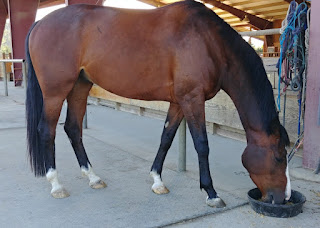By Mary Gallagher
From how far away can you catch your horse’s eye?
 |
| Laredo and Mary |
I caught one of my horses watching me the other day while he was grazing, facing away from me. But he definitely had me in sight, peering around his front legs and under his belly.
As prey animals, horses are visually astute, noticing things well before humans do. They can see up to a mile away, detecting movement in the distance. The horse’s eyes are set well apart on the sides of their head, so with minimal effort they can monitor their surroundings, front, back and sides.
Just yesterday I was working with Grasshopper in the round pen. He became alert, noticing something toward the back of our property—a section we call the Emerald Forest—a good eighth of a mile away. Well before I could figure out what had caught his attention, Grasshopper had picked up that his brother Laredo was coming through the trees, in our direction. By the time I realized it was Laredo, Grasshopper had already relaxed, knowing it was his herd mate coming through the woods, and not a predator.
I make it a point to be aware of my horse’s attention, especially in relation to me; when we are together, I want him connected to me. Fostering our connection in this way affects every aspect of our relationship, and definitely, my horsemanship, making the difference between my being a passenger or a partner.
 by Mary Gallagher
by Mary Gallagher








